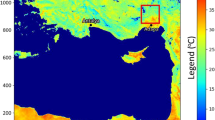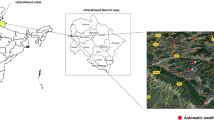Abstract
Land surface temperature (LST) data is essential for urban engineering as well as modeling the atmospheric phenomena. Such modeling efforts require accurate temperature prediction which is then used for predicting other meteorological phenomena such as urban heat island and fine dust air pollution. The automatic weather system (AWS) provides accurate temperature with high frequency but it cannot grasp spatially continuous distribution in detail because it is collected only at specific points. On the contrary, the LST data obtained from satellite imagery has a high spatial resolution and spatially continuous temperature can be grasped, but it is difficult to get high temporal frequency temperature data because of its revisit time. In this study, to solve this spatio-temporal tradeoff problem, a deep-learning method was used to create a spatially continuous temperature image using AWS data with a spatial resolution of 30 m. The seasonal temperature was predicted with accuracy of 3.6 °C for spring, 1.9 °C for summer, 3 °C for fall, and 1.4 °C for winter. The predicted temperature accuracy for spatial resolution of 30 m is better than other reported interpolation methods. In order to improve the prediction accuracy of the model, fine tuning procedures were applied to the deep learning model hyper parameters as well as the input feature data.





Similar content being viewed by others
References
Voogt, J. A., & Oke, T. R. (2003). Thermal remote sensing of urban climates. Remote Sensing of Environment,86(3), 370–384.
Pan, X., Zhu, X., Yang, Y., Cao, C., Zhang, X., & Shan, L. (2018). Applicability of downscaling land surface temperature by using normalized difference sand index. Scientific Reports,8(1), 9530.
Seo, K. H., & Park, K. H. (2017). Analysis of urban heat island intensity among administrative districts using GIS and MODIS imagery. Journal of the Korean Association of Geographic Informagion Studies,20(2), 1–16.
Keramitsoglou, I., Kiranoudis, C. T., & Weng, Q. (2013). Downscaling geostationary land surface temperature imagery for urban analysis. IEEE Geoscience and Remote Sensing Letters,10(5), 1253–1257.
Choe, Y. J., & Yom, J. H. (2017). Downscaling of MODIS land surface temperature to LANDSAT scale using multi-layer perceptron. Journal of the Korean Society of Surveying, Geodesy, Photogrammetry, and Cartography,35(4), 313–318.
Ahn, J. S., Hwang, J. D., Park, M. H., & Suh, Y. S. (2012). Estimation of urban heat island potential based on land cover type in Busan using Landsat-7 ETM+ and AWS data. Journal of the Korean Association of Geographic Information Studies,15(4), 65–77.
Lee, K. I., Ryu, J., Jeon, S. W., Jung, H. C., & Kang, J. Y. (2017). Analysis of the effect of heat island on the administrative district unit in seoul using LANDSAT image. Korean Journal of Remote Sensing,33(5), 821–834.
Ku, J. Y. (2014). Development of land surface temperature map generation method with landsat 8 TIRS imagery and automatic weather system data. Journal of the Korean Cartographic Association,14(1), 17–27.
Shin, H., Chang, E., & Hong, S. (2014). Estimation of near surface air temperature using MODIS land surface temperature data and geostatistics. Journal of Korea Spatial Information Society,22(1), 55–63.
Zhou, J., Chen, Y., Wang, J., & Zhan, W. (2011). Maximum nighttime urban heat island (UHI) intensity simulation by integrating remotely sensed data and meteorological observations. IEEE Journal of Selected Topics in Applied Earth Observations and Remote Sensing,4(1), 138–146.
Bechtel, B., Zakšek, K., Oßenbrügge, J., Kaveckis, G., & Böhner, J. (2017). Towards a satellite based monitoring of urban air temperatures. Sustainable Cities and Society,34, 22–31.
Berger, C., Rosentreter, J., Voltersen, M., Baumgart, C., Schmullius, C., & Hese, S. (2017). Spatio-temporal analysis of the relationship between 2D/3D urban site characteristics and land surface temperature. Remote Sensing of Environment,193, 225–243.
Mukherjee, S., Joshi, P. K., & Garg, R. D. (2015). Regression-kriging technique to downscale satellite-derived land surface temperature in heterogeneous agricultural landscape. IEEE Journal of Selected Topics in Applied Earth Observations and Remote Sensing,8(3), 1245–1250.
Bonafoni, S. (2016). Downscaling of landsat and MODIS land surface temperature over the heterogeneous urban area of Milan. IEEE Journal of Selected Topics in Applied Earth Observations and Remote Sensing,9(5), 2019–2027.
Yang, G., Pu, R., Huang, W., Wang, J., & Zhao, C. (2010). A novel method to estimate subpixel temperature by fusing solar-reflective and thermal-infrared remote-sensing data with an artificial neural network. IEEE Transactions on Geoscience and Remote Sensing,48(4), 2170–2178.
Kolios, S., Georgoulas, G., & Stylios, C. (2013). Achieving downscaling of Meteosat thermal infrared imagery using artificial neural networks. International Journal of Remote Sensing,34(21), 7706–7722.
Pereira, O. J., Melfi, A. J., Montes, C. R., & Lucas, Y. (2018). Downscaling of ASTER thermal images based on geographically weighted regression kriging. Remote Sensing,10(4), 633.
Hutengs, C., & Vohland, M. (2016). Downscaling land surface temperatures at regional scales with random forest regression. Remote Sensing of Environment,178, 127–141.
Jee, J. B., Lee, K. T., & Choi, Y. J. (2014). Analysis of land surface temperature from MODIS and landsat satellites using by AWS temperature in capital area. Korean Journal of Remote. https://doi.org/10.7780/kjrs.2014.30.2.13.
Zakšek, K., & Oštir, K. (2012). Downscaling land surface temperature for urban heat island diurnal cycle analysis. Remote Sensing of Environment,117, 114–124.
Gao, F., Masek, J., Schwaller, M., & Hall, F. (2006). On the blending of the landsat and MODIS surface reflectance: Predicting daily landsat surface reflectance. IEEE Transactions on Geoscience and Remote Sensing,44(8), 2207–2218.
Chollet, F. (2017). Deep learning with python. Greenwich, CT: Manning Publications Co.
Acknowledgements
This work was supported by the Korea Research Foundation (2015R1D1A1A01056884).
Author information
Authors and Affiliations
Corresponding author
Additional information
Publisher's Note
Springer Nature remains neutral with regard to jurisdictional claims in published maps and institutional affiliations.
Rights and permissions
About this article
Cite this article
Choe, YJ., Yom, JH. Improving accuracy of land surface temperature prediction model based on deep-learning. Spat. Inf. Res. 28, 377–382 (2020). https://doi.org/10.1007/s41324-019-00299-5
Received:
Revised:
Accepted:
Published:
Issue Date:
DOI: https://doi.org/10.1007/s41324-019-00299-5




